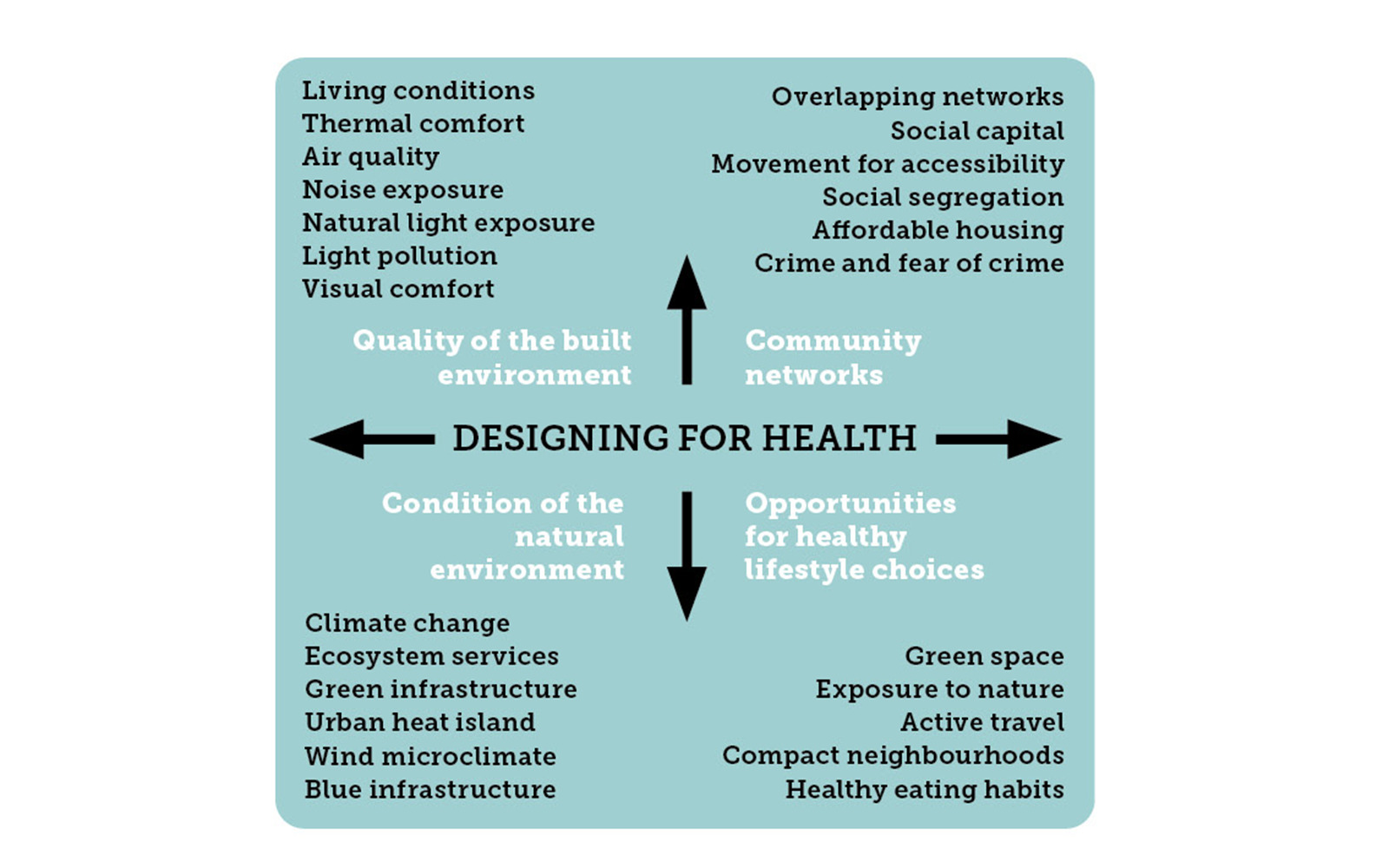Insights
Designing for health: part 1.
Building new development for better health outcomes.
This insight was first published on the 21/09/22 for IEMA
Development design has a significant collective influence on population-level health and wellbeing.
There is plenty of evidence that the design of a new development shapes the conditions in the built environment which are necessary for sustaining health and wellbeing. Unfavourable social, environmental and economic conditions lead to behavioural risks and disease patterns at the population scale that account for around half of all variation in health outcomes.
Figure 1: Key considerations when designing new development for better health outcomes.
Quality of the built environment
The link between health and the quality of the built environment is clear. Shelter is a basic requirement for sustaining life, but poor-quality buildings can create health problems of their own. The risk of developing a respiratory condition is higher in cold, damp accommodation, and is greatly reduced in buildings that are warm and energy efficient.
Indoor air quality issues can also exacerbate chronic health problems such as asthma and chronic obstructive pulmonary disease. Indoor pollutant sources include cooking, heating and smoking, but most indoor air quality issues originate in outdoor air pollution, which becomes concentrated inside. Road traffic emissions and tyre wear are the main causes of poor air quality in urban areas. Ventilation design in buildings can help to control the accumulation of these pollutants, and also mitigates overheating.
Overheating in buildings can be a problem for health, particularly for older people who are more susceptible to the effects of heat stress. There are approximately 2,000 heat-related deaths per year in England and Wales. However, the risk of overheating is predicted to increase with climate change, with heat-related deaths in England and Wales projected to rise to more than 7,000 per year by the 2050s. A growing and ageing population are also thought to be contributing factors.
Other sources of pollution also have an impact. The effects of noise pollution are often described in terms of annoyance, but excessive noise can harm both mental and physical health, causing anxiety, high blood pressure and changes in social behaviour. Noise disturbance is most common in poorly insulated high-density accommodation. Road, rail and air transportation, and mechanical plants such as construction equipment and air conditioning units, are also sources of noise. In contrast, natural soundscapes such as flowing water, breaking waves, rustling trees and singing birds have a positive impact.
Exposure to natural daylight and sunlight also has mental health and wellbeing benefits, which are mainly associated with entrainment of the body’s circadian rhythm. Moderate levels of sunlight also provide a source of vitamin D, which protects against a range of diseases, and is most easily be obtained during short periods of outdoor exposure. However, overexposure of skin to ultraviolet radiation from sunlight can also create health problems, associated with sunburn and increased risk of skin cancers.
Community networks
Overlapping networks within a community reinforce a sense of belonging that supports mental wellbeing. Within community networks, social capital refers to facilities that enable people to mutually co-operate, such as local schools, shops, pubs, indoor social spaces and outdoor green spaces. Walking to a community facility greatly increases the chance that a person will meet other members, providing an opportunity for social contact.
Where factors reduce the likelihood of people choosing to walk, there are fewer social interactions. For example, streets with higher levels of traffic have a greater sense of insecurity and lower levels of social interaction. Community severance is also a problem if high volumes of road traffic pass through a neighbourhood with inadequate crossing provision, resulting in real and perceived safety issues. Pedestrian and cyclist accessibility is improved by limiting vehicle speeds to below 25 miles per hour and providing traffic calming measures such as roundabouts and speed humps.
Social segregation occurs when inequalities exacerbate health inequalities – for example, where income deprivation influences the accessibility of local services such as shops, amenities and cash machines. Similarly, where housing is limited or in high demand, house prices can become disproportionately high in relation to income, resulting in the exclusion of those on low incomes. Health inequalities are exacerbated when the income-deprived have difficulty finding affordable housing in locations that are suitable for their needs.
There is a relationship between crime or fear of crime on physical and psychological health. Fear of crime makes people less likely to leave their home, use public spaces or public transport, and less likely to have chance social interactions with others. Provision of a range of mixed land uses and affordability of housing types is associated with improved safety perceptions in neighbourhoods. Similarly, urban design features such as street lighting and the installation of CCTV are associated with reduced fear of crime.
